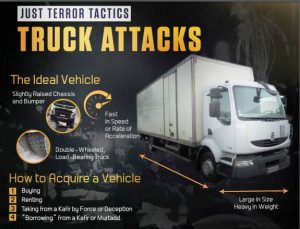Vehicular terrorism is not new, with Israel the scene of multiple attacks in past years. It’s becoming more and more common in the West, however, with attacks in NYC, London, Nice, France, Berlin, and elsewhere. A Somali student used his car to run over several people at Ohio State University and then perpetrated a knife attack on those who, ironically, ran over to see if he was injured. Many similar events have occurred, but rarely make the news, like reported by lewrockwell.com.
Why vehicular terror? Terror attacks are often associated with bombs, but making a bomb requires some expertise to assemble safely. Guns, the other preferred weapon, are difficult to come by in most countries other than the U.S. Owning or renting a vehicle, however, is easy. Trucks and cars can cause mass casualties if wielded as a weapon; obtaining one isn’t an act that evokes suspicion.
Early this year, an article titled “Just Terror Tactics” was published by the English-language ISIS magazine “Rumiyah”. It described which vehicles will cause the most damage and called for attacks on Western crowds. “It is a simple idea and there is not much involved in its preparation,” the article said. “All what is needed is the willingness to give one’s life for Allah.”
The article goes on: “Pick your location and timing carefully. Go for the most crowded locations. Narrower spots are also better because it gives less chance for the people to run away. Avoid locations where other vehicles may intercept you…”
“To achieve maximum carnage, you need to pick up as much speed as you can while still retaining good control of your vehicle in order to maximize your inertia and be able to strike as many people as possible in your first run.”
The writer also suggested attackers weld steel blades onto the front of an SUV: “They do not need to be extra sharp because with the speed of the truck at the time of impact, even a blunter edge would slice through bone very easily. You may raise the level of the blades as high as the headlights. That would make the blades strike your targets at the torso level or higher.”
These tactics represent the new blueprint among terrorists for causing mayhem. Few people pay much attention to traffic unless they’re driving a vehicle themselves or crossing the street. The speed at which a vehicle can accelerate and turn into a crowd leaves little reaction time. Therefore, the “success” rate of this type of terror event may surpass even a gunman’s ability to cause deaths and injuries.
I advocate for a constant state of “Yellow Alert” when in public spaces. By that, I mean a calm but vigilant observation of what’s happening around you. Look for anomalies in behavior that might warn you of nefarious intentions. For example, hopping up and down and screaming may be normal at a rock concert, but it’s an anomaly at Starbucks.
This attitude is useful, but it’s difficult to respond quickly enough to avoid an oncoming car or truck. When a vehicle moves erratically or leaves the normal pattern of traffic, it’s an anomaly that requires quick action. Mentally noting routes of escape whenever you’re in public will give you the best chance of escaping. Just as knowing the location of exits in a mall or theatre is good policy, a heightened awareness is now important at any public area near roadways.
For vehicular terrorists, the target will be crowds of people near the street. Their objective is mass casualties, and those pedestrians nearest the curb will bear the brunt of the attack. Consider walking on the fringe of a crowd away from the road to give yourself the most options. In the center, the masses, not your own good judgment, will dictate your movement.
Municipalities can protect their citizens from vehicular terrorism by constructing barriers known as “bollards” which stop vehicles from entering pedestrian areas. These can be seen outside many government buildings and airport terminals. Expanding their use to areas that attract crowds would be an important consideration for the future.
I’m not the only one thinking of how to deal with vehicular terror. The FBI and the Department of Homeland Security issued a release warning of vehicular terrorism and how to identify an imminent attack. The release acknowledges the time issues in reacting to such events, but includes the following things to look for:
- Unusual modifications to vehicles, such as frontal reinforcement.
- The purchase or rental of large or heavy-duty vehicles, especially if there is nervousness during the transaction, payment in cash, or lack of familiarity with the vehicle’s operations.
- Commercial motor vehicles or heavy equipment being operated in unusual locations, such as particularly heavy pedestrian areas.
- Attempts to approach areas closed to traffic, such as street festivals or farmers’ markets.
- A vehicle operator’s apparent unfamiliarity with operating a commercial vehicle, such as trouble with gear shifting.
I’ll admit that the likelihood you’ll be in the path of a terrorist using a vehicle, or any other weapon, is very small. Panic isn’t the answer, but these are troubled times; the more situationally aware you are, the safer you’ll be.



